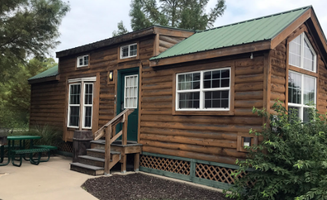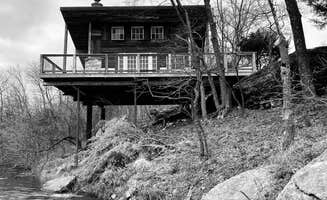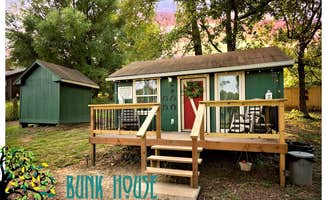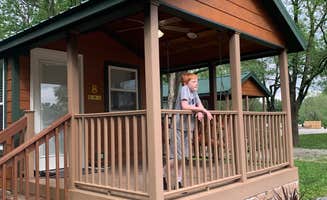Cabin camping near Liberty, Missouri offers numerous options within a 40-mile radius. These accommodations vary widely in size and amenities, ranging from rustic bunkhouses to fully-furnished cottages with modern conveniences. Winter cabin bookings are available at several locations, though reduced amenities and seasonal closures affect some properties from November through March.
What to do
Fishing opportunities: Watkins Mill State Park Campground provides a small lake ideal for kayaking and fishing. "There is a small lake great for kayaking and fishing boats. The swim beach has been closed because of excessive vegetation growth," notes a visitor. The 100-acre lake includes a boat ramp and non-motorized boating is permitted.
Historical exploration: Visit the historic woolen mill at Watkins Mill State Park Campground. "If you like history, take a tour of the woolen mill part. Very cool," shares a camper. The park includes a 3.8-mile paved trail that connects to the campground and circles the lake.
Theme park access: Cabin guests at Worlds of Fun Village receive discounted admission to adjacent amusement parks. "The theme park offered discounted tickets when staying at the campground and parking for the parks was included. Worlds of Fun and Oceans of Fun are internally connected, making it easy to walk between the two," explains a reviewer.
What campers like
Swimming amenities: Lake Paradise Resort features a renovated zero-entry pool. "The pool is renovated and very nice. It is very large, zero entry, up to mostly around 5 ft deep with a small area that was 9ft; there is a children's area with a sprinkler," describes one camper who enjoyed the facilities.
Seasonal activities: Basswood Country RV Resort organizes family-friendly weekend events. "Every weekend there are organized activities such as arts and crafts, fishing contests, duck races and frozen t-shirt contests in the pool, and a Saturday evening outdoor movie," explains a longtime visitor.
Secluded settings: Green Acres at Red Brick Farmhouse offers a peaceful rural environment. "Small, secluded camp sites on picturesque lawn surrounding 3-story red brick farmhouse near Higginsville, MO. Two tent sites. Two or three small RV sites and one parked RV trailer available as a nightly rental," explains a visitor who appreciated the tranquility.
What you should know
Airport proximity: Cabin rentals at Basswood Country RV Resort experience air traffic. "The campground is on the final approach for the airport, so you get to see a lot planes flying overhead, which you don't even notice cause they are quieter than they used to be, and I think they shut down flights around 10pm," reports a guest.
Advance reservations: Most cabin facilities require booking weeks ahead, especially during summer. The Kansas City East-Oak Grove KOA offers cabins year-round but summer weekends fill quickly, often 3-4 months in advance.
Variable privacy levels: Site layouts affect privacy at different cabin locations. "Cabins are okay and meet basic needs but are not cleaned thoroughly," notes a visitor to Worlds of Fun Village. At other locations, cabin spacing provides more seclusion.
Tips for camping with families
Kid-friendly activities: Kansas City East-Oak Grove KOA offers family amenities including free breakfast. "The free pancake breakfast was great and they had fun kids activities. Nice doggie playground with grass," shares a visitor who appreciated the family-oriented offerings.
Playground access: Many cabin locations include play areas. At Watkins Mill State Park, "We would go out extra early to set up then spend our time on the bike trails until lunch. We always brought our own grill but theirs were nice as well," recalls a camper who visited with children.
Swimming options: Cabin guests should check seasonal pool availability. "Too late in the year for the pool to be open but looked nice. Would camp again," notes a September visitor to Lake Paradise Resort, where the pool typically closes after Labor Day.
Tips from RVers
Site positioning: At Worlds of Fun Village, cabin and RV location affects noise levels. "Row 1 (sites 1-20) is along a busy highway with semi truck noise 24 hours a day. I recommend either paying more for the pull-through (further from the road) or the back in sites 69-82 in row 3," advises an experienced visitor.
Utilities information: Lake Paradise Resort cabins and RV sites have varying hookup quality. "The sites are old and not very level and difficult to maneuver. Lots of seasonal campers but it could be a 4 star campsite with some upgrades," notes a recent guest.
Supply planning: Cabin campers need to bring specific items. At most locations, linens aren't provided, and kitchen supplies are limited. Check individual cabin listings for what's included as amenities vary significantly between locations.





